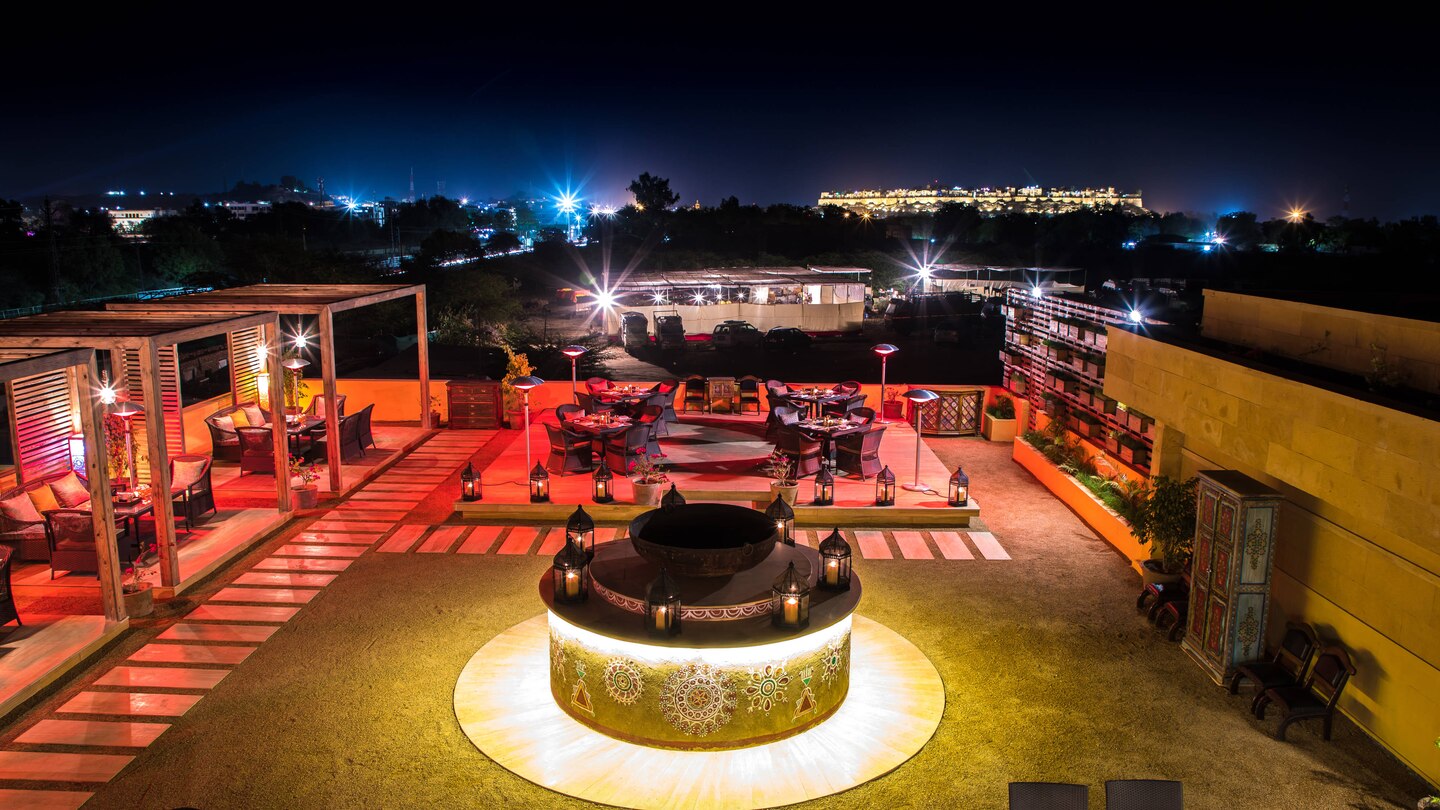With a legacy of more than 125 years, the magnificent Aga Khan Palace in Pune stands as a glorious testament to history, heritage, and architecture. At the same time, its role in the country’s freedom movement places it amongst the most significant landmarks in India’s modern history. The palace had once served as a prison where Mahatma Gandhi and other eminent leaders of the freedom struggle were lodged. Currently, it serves as the headquarters of the Gandhi National Memorial Society and is a prime tourist attraction in Pune. If you are planning to book your hotels in Pune for a trip, make sure to include it in your itinerary.
Looking for more details on this top historical attraction in Pune? This blog gives you a snapshot of everything you should know about Pune’s Aga Khan Palace, including its history, architecture, timings, entry fee, and other interesting and lesser-known facts.
About Aga Khan Palace

Built in 1982 by Sultan Muhammed Shah Aga Khan III, the Aga Khan Palace is a magnificent piece of history situated in 19 acres of land in the Yerwada area in Pune.
Referred to as one of the most important landmarks of Indian history, along with the Indian freedom struggle, the palace has its roots deeply etched into bygone eras.
The palace was built to help the poor in the areas surrounding Pune, which was drastically hit by famine in the early 1980s.
One of the most stunning pieces of architecture in all of Pune, the Aga Khan Palace is also a famous tourist attraction, which was designed by a world-famous architect called Charles Correa.
Additionally, the palace houses the samadhis (memorials) of Mahatma Gandhi’s wife, Kasturba Gandhi. Sources suggest that both Kasturba Gandhi and Mahatma Gandhi’s secretary Mahadev Desai breathed their last in the palace premises. And it is because of this that their memorials have been safeguarded in the palace grounds.
The Aga Khan Palace is located in a huge ground, and has five, luxurious and spacious halls, along with several lawns. The structure resonates of Italian architecture, elegant yet intricate and magnificent.
Of all the rooms and features of the palace, its arches are the most beautiful, almost mesmerising to the eyes. Aga Khan Palace has two huge floors, in addition to a corridor which spreads across the entire structure.
The palace is known for organising several exhibitions and programmes throughout the year. Most of these reflect Gandhi’s lifestyle, thereby offering visitors a deep insight into the Mahatma’s life.
Moreover, it is because of this and Gandhi’s links to it that the palace is now also known as the Gandhi National Memorial Society. One of the most prominent attractions of the palace is the room where Gandhi stayed during his imprisonment, along with his personal belongings and pictures of the other freedom fighters. |
History of Aga Khan Palace:

The Aga Khan Palace has a deep-rooted history with the Indian freedom struggle and Mahatma Gandhi attached to it.
After the Quit India Movement was launched, this palace acted as the prison/ detention centre for Mahatma Gandhi, his wife Kasturba Gandhi as well as his secretary Mahadev Desai, between August 1942 to May 1944. Additionally, many known figures of the freedom struggle such as Sarojini Naidu were also imprisoned here during 1942.
It is during this time that Kasturba Bai and Desai took their last breaths here. Subsequently, the Mahatma buried them here, thereby establishing their memorials in the palace premises. Gandhi and the others were kept imprisoned in the palace for almost two years before they were released in May 1944.
Subsequently, in 1969, Aga Khan donated the palace to the Government of India. And it is after this, that the Aga Khan Palace came to be known as the Gandhi National Memorial. Later, in March 2003, the palace was declared as a “Monument of National Importance” by the Archaeological Survey of India.
As of now, the rooms, where Gandhi and others used to stay, serve as a museum. They are the surviving testimony to the struggle of India’s independence. Gandhi’s belongings from the times of his stay are exhibited here as well.
Architecture of Aga Khan Palace:
Located in a sprawling area of 19 acres in Pune’s Yerwada area, the Aga Khan Palace is famous for its amazing blend of Islamic and Italian style of architecture. It is a unique combination of Italian arches and huge luxurious lawns, with the finer Islamic details on it.
The palace is known to have expansive, well-maintained lawns built on an area of 7 acres, along with five magnificent halls in its premises. Moreover, a 2.5-metre-wide corridor encircles the palace, which has two storeys. The palace was designed by the renowned architect Charles Correa.
The Aga Khan Palace is a great example of the interweaving between the European and the Saracenic styles of architecture.
Having a built-up area of almost 28,000 square metres, the presence of many beautiful French lawns, fountains, long corridors, spacious rooms, rose style windows as well as Italian arches enhances the opulence of the palace even more.
Today, the Aga Khan Palace serves as the headquarters of the Gandhi National Memorial Society. Furthermore, it houses several beautiful exhibits of those times, including the personal belongings of the Mahatma.
Additionally, it also has many photographs and artefacts associated with the Gandhis and other freedom fighters of the Indian Freedom Struggle.
Celebrations at Aga Khan Palace:

Many public functions and important days and dates are celebrated at the Aga Khan Palace. All of these celebrations are organised by the Gandhi Memorial Society. Some of the celebrations at the Aga Khan Palace include Martyr’s Day, which is celebrated on January 30.
Additionally, the palace also celebrates Maha Shivrati, which is death anniversary of Kasturba Gandhi and is celebrated lavishly as Mother’s Day.
Along with this, the palace celebrates 15th August, Independence Day, 26th January, as Republic Day, as well as Mahatma Gandhi’s birth anniversary on 2nd October every year.
The palace gets lit up in all its glory on all of these days, shining like a bright star above Pune’s Nagar Road. Other than these annual events, sessions for morning prayer are being held at the samadhi every day for decades. Huge crowds turn up for these prayer sessions, which increases tenfold during the annual events.
Gandhi Museum:
The Aga Khan Palace houses the Gandhi Museum which displays many artefacts and things of the times gone by.
It is amongst the most frequently visited place in the palace premises by tourists. In addition to paintings, sculptures, murals and photographs of the India Freedom Struggle, the museum also houses the personal belongings of Mahatma Gandhi and the Gandhi family.
This includes Gandhi’s letters, clothes, towels, as well as slippers, among other things.
Additionally, the rooms, which were used by Mahatma Gandhi, his wife Kasturba Gandhi, his secretary Mahadev Desai and Sarojini Naidu have also been well-preserved and are open for public display as part of the museum. The room which was used by Sarojini Naidu has a poem displayed in it.
The poem is written by Padma Sethi. Along with the poem, the room also has pictures of Indira Gandhi and many other leaders who were a part of Quit India Movement and the freedom struggle.
The museum also has the room which was occupied by Gandhi. A spacious room, it also has a huge hall, which presents his writing desk, his charkha, as well as his sandals and other personal belongings.
One of the main attractions of the room is a painting of the Mahatma and Kasturba Gandhi, wherein the latter is resting her head on Gandhi’s lap. The dining area, which was used by them, is also a part of the museum and is available for public viewing.
The museum is also home to the final resting place of Kasturba Gandhi as well as Mahadev Desai, who breathed their last whilst in imprisonment here at the palace.
Aga Khan Palace & Mahatma Gandhi

Aga Khan Palace served as the prison for Mahatma Gandhi in Pune from Aug 1942 to May 1944. He lived here along with his wife Kasturba, his secretary Mahadev Desai & Sarojini Naidu. In fact, both Kasturba Gandhi and Mahadev Desai died in the premises of this Palace turned prison. A corner of the Palace premises serves as the Samadhi dedicated to two of them. Some of the ashes of Mahatma Gandhi are placed next to the two samadhis. Samadhis are nothing but Tulasi plants growing on top of the places where Kasturba and Mahadev Desai were cremated.

A poem in Marathi dedicated to Kasturba adorns a red wall nearby.

Honestly, when you walk around this Palace with sprawling gardens, long corridors, and huge rooms, you wonder if you could really call it imprisonment. I assume there was no restriction on movement within the large campus of the palace. Maybe the residents could even step out – this was an era long before media watch came in vogue.
Who is Aga Khan?

Sir Sultan Muhammed Shah Aga Khan III was the 48th Imam of Khoja Ismaili Muslims. He was the founder of All India Muslim League and actively worked towards the rights of Muslims in India. He was one of those who demanded the creation of a separate nation-state for Indian Muslims albeit within India.
Aga Khan III was born to an elite family in Karachi and attended Eton & Cambridge University. During his life, he received quite a few distinctions from the British Government. Notice the prefix Sir before his name. He owned many racing horses. He married multiple women in his lifetime. Before getting buried in Aswan, Egypt, he authored a few books including his own memoirs.
Aga Khan Palace, Pune Information:
| Location | Kalyani Nagar, Pune |
| Type | Palace |
| Also known as | Gandhi National Memorial |
| Timings | 9:00 am to 5:30 pm; every day except national holidays |
| Entry Fee | ₹ 5 for Indians; ₹ 2 for children; ₹ 100 for foreigners |
| Year of Construction | 1892 |
| Commissioned By | Sultan Muhammed Shah Aga Khan III |
| Area | 19 acres |
| Status | A monument of national importance, the Headquarters of the Gandhi National Memorial Society |
| Governing Body | Gandhi National Memorial Society |
| Cost of Construction | 12 lakh Indian rupees |
| Architectural Style | Islamic style |
Aga Khan Palace, Pune: Today
Today, the Aga Khan Palace serves as a memorial to Gandhiji and his philosophies and is one of the top historical places in Pune. The samadhis (tombs) of Kasturba Gandhi and Mahadevbhai Desai are located within the palace premises. There is a samadhi dedicated to Mahatma Gandhi as well, where his ashes are kept.
The palace also houses a museum where a rich collection of memorabilia related to Gandhiji are preserved and displayed. This includes photographs, pictures, and his personal items like clothes, utensils, slippers, and a letter penned by him on his secretary’s death. There is even a shop within the premises where clothing made of handloom textiles and khadi are sold.
Every morning, prayer sessions are held at Gandhiji’s Samadhi, which is attended by a large number of people. The number of attendees increases by many folds on 2nd October on the occasion of Gandhiji’s birth anniversary.
How to Reach Aga Khan Palace

Aga Khan Palace is located around 3.7 kilometres from the Pune Airport. You can avail a taxi or book online or even take your own car to reach to the Aga Khan Palace comfortably and faster.
The route from the airport is quite a convenient and straight one, with no major left or right turns on the street intersections.
Most auto rickshaws and state or private buses departing from the airport can easily take you to Nagar Road, where Aga Khan Palace is situated. Usually, a drive from the Pune Airport in a cab can take between 12 to 20 minutes, depending on the traffic.
Best Time to Visit Aga Khan Palace

The best time to visit Aga Khan Palace is between the months of late September or early October and April. It is during these months when the weather here is absolutely pleasant and perfect for exploring the panoramic surroundings of the historical palace.
Moreover, the days mostly remain clear in October, with a little bout of downpour here and there, but not too much to spoil your day out enjoying the palace and its history.
Summer: The months from March to early June are the hottest and the most oppressive months in the city. A visit to Aga Khan Palace during this time is inadvisable, since temperatures can soar to almost 40 degrees Celsius at this time.
Monsoon: June to September are the cool monsoon months, with July being the wettest month of the year. During this time, visiting the gardens here at the palace is quite difficult, due to dirt and slippery grounds.
Winter: December to February in Pune are the winter months. The weather at this time of the year remains below 25 degrees Celsius.













16 Comments
Comments are closed.